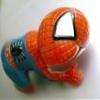Search the Community
Showing results for tags 'Endangered'.
-
Sighting of endangered monkeys using rope bridge to cross road gives hope their numbers will expand source: https://www.straitstimes.com/singapore/environment/sighting-of-endangered-monkeys-using-rope-bridge-to-cross-road-gives-hope?utm_medium=Social&utm_campaign=STFB&utm_source=Facebook&fbclid=IwAR3cd-kcvJC_x9f7Sc3nukYUQNCuQofc9sFre84MHu6n0eXfzxf_nR03LpY#Echobox=1587123524 SINGAPORE - The sight of a monkey climbing a rope bridge to cross a road may not be noteworthy to most people. Most would not have noticed the bridge across Old Upper Thomson Road, which was built by the National Parks Board (NParks) in October 2019 to help animals cross from the vegetation in Thomson Nature Park to the forests in the neighbouring Central Catchment Nature Reserve. But a new video showing three critically endangered Raffles' banded langurs using the rope bridge has excited conservationists here. The video was posted by NParks on Thursday night (April 16) on its social media channels. It shows the shy, black-and-white monkeys using the bridge to cross the dual-lane road. As they make their way from one end to the other, a car drives by under them. Primate scientist Andie Ang, who has been studying the langurs for about a decade, said the footage from the camera trap marked the first time she saw the shy langurs using a crossing aid to move across two forests. The langur, found only in a cluster of forests in the Central Catchment Nature Reserve and a number of surrounding buffer forests, is one of two monkey species in Singapore. The other is the brown-furred long-tailed macaque, which is more commonly seen in parks. Dr Adrian Loo, NParks’ group director for conservation, said langurs have been spotted using the rope ladder bridge on multiple occasions since last August. The most recent sighting, which comprised a troop of langurs crossing the bridge from Thomson Nature Park to Central Catchment Nature Reserve, was observed on April 6, said Dr Loo. Dr Ang, a Wildlife Reserves Singapore Conservation Fund (WRSCF) research scientist, said the sighting is significant as it shows that the arboreal bridge is useful in allowing wildlife to cross safely. This connectivity is crucial for this species as it could expand the forested areas the langurs can access to find food and mates, she added. There are only 63 Raffles' banded langurs left in Singapore. Earlier research by Dr Ang and five other scientists from the National University of Singapore and Andalas University in Indonesia showed that the genetic make-up of this species - which can also be found in southern Peninsular Malaysia - is distinct enough to be considered a species of its own. There are two other langur species in the region. Second Minister for National Development Desmond Lee shared the video in a Facebook post on Thursday evening and said that Thomson Nature Park is a key conservation site for Singapore's rare native biodiversity, including the langur. "The habitats and ecological connectivity of the area had been enhanced for the langurs," he explained. "Rope bridges between the nature park and the adjacent Central Catchment Nature Reserve act as canopy linkages to keep them safe from traffic." MONKEYS CROSSING Thomson Nature Park is home to about three troops of langurs, including one comprising five bachelors, said Dr Ang. The other two are family units comprising an alpha male, females and their young. Previously, the langurs had used the natural canopy of the trees on both sides of Old Upper Thomson Road to cross. But tree pruning in 2017 had disrupted this connectivity, she noted. "After that, volunteers saw the langurs descending to the ground to make the crossing. "But unlike macaques, langurs are arboreal animals and are uncomfortable travelling on the ground," she said. It took consistent monitoring over the years by Dr Ang and Ms Sabrina Jabbar, a WRSCF project assistant, as well as volunteers who had joined a citizen science survey, to narrow down the most likely location along the 3km-long Old Upper Thomson Road that the langurs were likely to use again. "Based on the observations, we recommended the location for the bridge to NParks," said Dr Ang, who chairs the Raffles' banded langur working group, comprising representatives from NParks, WRS, the Nature Society (Singapore) as well as volunteers. She added that more rope bridges or other artificial crossing aids could be used to facilitate the movement of wildlife in Singapore's fragmented forest landscape. But such bridges need to be regularly maintained to ensure the safety of animals using them, as well as that of pedestrians and vehicles below, she said. "Such devices should not be seen as an alternative to preserving habitat and maintaining natural canopy connectivity," she said. "After all, it also takes time before animals begin to use them." NParks’ Dr Loo said the Board will be installing more rope ladder bridges to enhance connectivity for arboreal animals. Giving an update on the first single-rope bridge that NParks installed in February 2018 across Upper Seletar Reservoir, Dr Loo said it has been removed with the conclusion of a trial, as there is currently no need for enhanced aerial connectivity at this site. The trial had looked at different forms of aerial connectivity and tested the feasibility of the single rope bridge design. Single-rope bridges were found to require higher maintenance and to not be as animal-friendly as rope ladders, Dr Loo said. He added: “As a result of the trial, a second rope ladder bridge has been installed earlier this year across Old Upper Thomson Road at a spot in the canopy that is frequented by the langurs. This complements the original rope ladder bridge that was installed last year.” Dr Loo said NParks will continue to work with the Raffles’ Banded Langur working group to identify new crossing sites. In his Facebook post on Thursday, Mr Lee urged people to remain indoors during the current circuit breaker period, saying that Singapore's wildlife will still be around for people to admire after the crisis. He said: "During this critical period, it is important that all of us stay home and keep ourselves and our families safe from the threat of Covid-19. "Our biodiversity is keeping well, and will still be around for us to visit and admire, after we have overcome this pandemic."
-
Bring tears to my eyes. <youtube>_4q2KjWG-9Q</youtube> Somehow I cannot embedd. This is the link:
-
- endangered
- Species
-
(and 2 more)
Tagged with:
-
For the first time in a very long time i spotted my dream ride on sgcarmart. Someone please save this endangered species. http://www.sgcarmart.com/used_cars/info.php?ID=31059&DL=1000 If i had 150K lying around i'd definately grab it.



